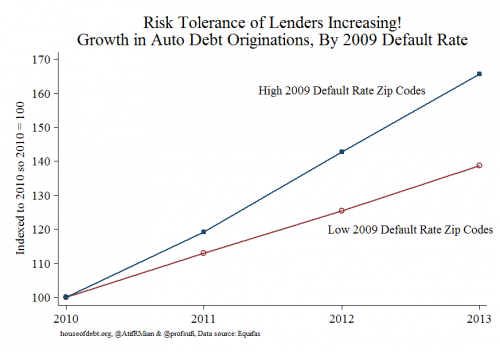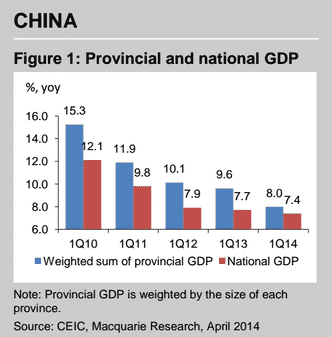US and European recoveries continue as China decelerates
The monthly employment situation summary for April 2014 was released by the US Bureau of Labor Statistics. And the headline numbers were terrific. The unemployment rate measured by the household survey fell to a cyclical low of 6.3%, below the Evans Rule threshold. Meanwhile, the establishment survey showed a net addition of 288,000 works to non-farm payrolls. The fact that both the household and establishment surveys showed marked improvements tells you that the jobs picture in the US has improved.
Some of the data underneath the headlines was a bit murky. For example, the labor force participation rate fell 0.4% to 62.8%. Hourly and weekly earnings were both unchanged, and the labor force shrunk by 806,000. But other important data points were broadly positive.
- The unemployment rate is the lowest since September 2008
- The 3-month average addition to non-farm payrolls is now +238,000
- The number of unemployed persons fell 733,000
- Broad unemployment as measured by U-6 fell to 12.3% from 12.7%
- 2.4 million full-time jobs have been added over the last year while part-time employment has fallen 255,000
- Long-term unemployed dropped 287,000 to 3.5 million, the lowest since March 2009.
The bottom line here is that the US recovery is now officially not just a statistical recovery. It is also a jobs recovery.
Attention will now turn to the Fed and its reaction function. Yellen has been able to taper large scale asset purchases at a consistent $10 billion rate but after this report it is clear that the Fed is going to err toward more aggressive tightening if anything. Any attempts to pause tapering will be met with dissent from Plosser, Fisher and others. The whole spiel about waiting for the labor market to recover is now moot.
From a cyclical perspective there are two ways for this expansion to continue given consumption is two-thirds of the US economy. One way is for consumers to releverage and dissave. And we are seeing this. The personal consumption data out yesterday showed the personal savings rate in the US now down to 3.8%. Another way for the cycle to continue is for workers to receive higher wages and more jobs. We are seeing the jobs numbers tick up. But wage data is not especially good. Last month it was stagnant. Moreover, the Fed’s reaction function is such that I do not expect the Fed to stand idle as wage rates tick up. Every time they have done so in the past thirty years, the Fed has moved against them except in the late 1990s. And the late 1990s ended in the TMT bubble.
Attention will turn to inflation, and to lesser degrees to credit availability and financial stability.
On the credit side, I have consistently argued that credit has loosened measurably. American subprime lending is back on the road, now via auto and student loans. Wells Fargo, for example noted in its most recent earnings report that it had originated $7.8 billion in auto loans, a 15% increase year-over-year. Much of this is likely via an originate to distribute business model via auto asset-backed securities.
Five years ago, subprime loans represented barely one—tenth of auto loans.Now, subprime is one-third of the business. Atif Mian and Amir Sufi recently looked at risk tolerance of lenders via growth in auto loan origination by American zip code default rate. What they found was a much larger increase since 2010 in lending to zip codes with high default rates compared to zip codes with low default rates.
Auto debt originations have increased by almost 70% from 2010 to 2013 in the riskiest zip codes. They have increased by only 30% in the safest zip codes. The difference is especially pronounced in 2012 and 2013. Lenders are extending much more credit in the riskiest areas.
And though revolving credit numbers have decreased of late, the two professors found the exact same outcomes in credit card lending.
In the corporate arena, I have also written about the increase in lending to high yield enterprises and the laxity in lending covenant standards. Strong demand in syndicated loans and high yield is driven by steady inflows from retail and institutional investors reaching for yield. There are now $2 trillion worth of junk bonds outstanding, up from just $1 trillion in March 2009, according to BofA Merrill Lynch index data.
Andy Lees of the Macro Strategy Partnership noted this morning the following regarding a statement from US Bancorp:
“We will continue to compete on price” according to US Bancorp, adding that its funding costs are lower than its rivals. Federal data showed total commercial and industrial loans outstanding reached a record USD1.69trn for the week ending April 16th, up an annualised 12.4% in Q1 from 7.2% in Q4 last year. Perhaps this rapid loan growth is why the default rate is so low. In December the Office of the Comptroller of the Currency, which regulates banks with branches in multiple states, warned that low delinquency rates over a prolonged period may spur the banks to take on too much risk.
All of this is necessarily an outgrowth of reaching for yield due to a low nominal interest rate environment. Indeed, short-term interest rates are negative in real terms as they have been for six years.
Let me briefly touch on two other economies. In Europe, the PMIs came out and they showed continuing expansion. Markit said the purchasing managers index for manufacturing rose to 53.4 from 53.0 in March. That’s higher than the preliminary estimate of 53.3 they released last month.
Greece moved into the expansion camp once again as well. Markit’s purchasing managers’ index for manufacturing rose to 51.1 in April from 49.7 in March. Manufacturing accounts for about 10 percent of the Greek economy. SO this is not the end all survey. Nevertheless, directionally it says that Greece is in a tepid expansion.
Unfortunately, the EU statistics agency also said that the euro zone’s unemployment rate was unchanged at 11.8% in March. Now, Eurostat also said the number of jobless fell by 22,000 in March, bringing the total decline to 316,000 in the past year. But this is small beer in the grand scheme of things. Europe’s recovery remains weak because of the joblessness. And this makes Europe much more susceptible to a recessionary relapse from exogenous shocks.
In China, another data point on deceleration is worth pointing out. This comes via Maquarie Bank via Macro Business.
Local governments turn more conservative in reporting GDP. Up until April 28, all provinces in China except Shaanxi had reported 1Q14 GDP growth figures. Weighting them by the GDP level of each province, we get 8.0% yoy in 1Q14, compared with the 7.4% national GDP growth from the NBS (Figure 1). In the past four years, the ratio between these two has never fallen below 1.2 (Figure 2). Does this mean China only grew 6.5% in 1Q14?
We don’t think so. A more plausible explanation is that local governments began to systemically reduce the over-reporting of their growth figures. Why?
- Deleveraging as the top priority for local governments: Local officials used to engage in a tournament competition for GDP growth, resulting in a fast accumulation of local government debt (~30% annual growth). Since last Dec, local officials seem to sense the pressure for deleveraging from Beijing.
- Consequently, they are turning more conservative in playing the old game as higher growth often entails faster debt accumulation. Moreover, the national debt audit last year made it harder to attribute newly raised debt to their predecessors. As the result, 23 provinces lowered their growth target for 2014 and only one province (Guangdong) raised it. Even so, in 1Q14, all provinces in China except one missed their new growth targets.
- It’s a change for the better, but could it last? We tend to give the benefit of doubt at this moment, but only time will tell. First, if growth falls below 7%, Beijing may have to get local governments involved in stimulating the economy; Second, the recent slowdown in some resource-intensive provinces may force them to return to the old track; Third, to compete for promotion, local officials always face the temptation to achieve higher growth by leveraging up, and they may take notes from the front-runners.
- Who are the front-runners in 1Q14? They are Chongqing (10.9%), Guizhou (10.8%) and Tianjing (10.6%). This is not surprising, as they have been the fastest in the past five years. Tianjing has become the national growth champion since 2010, driven by fast investment growth. From 2008 to 2013, the annual investment growth was 30%, 9% and 5% in Tianjing, Beijing and Shanghai, respectively. Guizhou is another investment-driven story, with the highest FAI growth rates across all provinces in 2012, 2013 and 1Q14.
- Chongqing is featured as an emerging export machine (mostly processing trade). From 2010 to 2013, the average annual export growth for Chongqing was 89%. In 1Q14, Chongqing’s exports grew 66% yoy, compared with -3.4% at the national level.
- Resource-intensive provinces are hit heavily in 1Q14, including Heilongjiang (to 4.1% in 1Q14 from 8.0% in 2013), Hebei (to 4.2% from 8.2%) and Shanxi (to 5.5% from 8.9%). These are provinces intensive in resource, specializing in oil, steel and coal production respectively. It’s in line with the industrial profit data released over the weekend, pointing to a soft upstream, mixed midstream and held-up downstream sectors.
What’s the bottom line there? China will continue to decelerate. But at some point it is going to hit an area where deceleration is either destabilizing from a financial perspective or negative for employment. At that point, the experiment with rebalancing will turn toward reflation again. I believe we will be there before the fall begins.


Comments are closed.